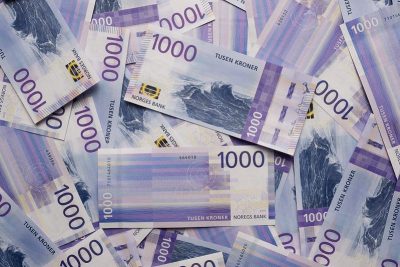The Norwegian krone has strengthened markedly in recent weeks, as has the country’s economy in general. It’s a case of the rich getting richer, as the energy crisis boosts the price of Norway’s oil, gas and electricity at the expense of its trading partners.

The krone (crown), which rises and falls in line with oil prices, has been on a roll this autumn. It weakened considerably after oil prices collapsed when the Corona crisis began in the spring of last year. At some points it cost nearly NOK 11 to buy one US dollar.
After oil prices bottomed out, however, the krone began a slow but steady rise. Now it costs around NOK 8.40 to buy a dollar. That’s still much weaker than during the glory days of the oil boom years, but it’s enough to grab attention. The krone has also strengthened markedly against the euro and the Swedish krone.
It’s mostly because of the energy crisis that’s set in over the past several weeks. “The strong krone hangs together with the oil and gas price,” analyst Bjørn Roger Wilhelmsen, chief economist at Nordkinn Asset Management, told newspaper Dagens Næringsliv (DN) last week. “The correlation between the oil price and the krone is especially strong because the global energy crisis is now the main issue for all investors.”
Record-high trade surplus
Not only have oil prices jumped, so has the price of Norway’s gas and its hydro electric power. Norwegians themselves are suddenly getting sky-high electricity bills that have doubled in the past month and heading higher, but so are all of Norway’s customers abroad and the money is pouring into the national treasury.
That led to a record-high trade surplus for Norway last month. High prices for Norway’s biggest exports resulted in a surplus of NOK 53.7 billion last month, according to state statistics burean SSB. Norway exported goods valued at NOK 129.5 billion, reports SSB, up 11.9 percent over August. The export value of Norway’s seafood, which rose to NOK 11.5 billion, was also the highest ever in September and October’s numbers are bound to be high, too.
Many analysts think oil and gas prices will continue to rise, at the same time Norway’s central bank has finally begun to raise interest rates. The bank acted quickly when the Corona crisis began to slash rates down to zero as a means of stimulating the economy. That’s no longer needed, the bank boosted its key policy rate to 0.25 percent last month and more increases are in line. That usually boosts the country’s currency, too.
But it’s the oil and gas prices that continue to keep Norway’s oil industry so valuable that government leaders won’t rein it in even in the midst of the climate crisis. Norway’s new government claims it will have an “active” climate policy and that it will cut emissions, but the oil and gas will keep flowing. One of former Oil Minister Tina Bru’s last assignments was to meet energy ministers in Brussels, for both the EU and Belgium.
“There’s no doubt,” Bru could tell DN afterwards, “there’s a need for the gas we’re exporting.” While Norway’s Greens Party want to stop exploring for more oil and gas sources and start phasing out production, Belgium’s Greens Party wants to increase gas consumption as an alternative to nuclear power for industry. Norway’s gas is also needed in Great Britain, where it’s used to heat most homes.
“You can’t just turn off the gas and go over to electricity,” Bru told DN. “There’s no doubt that Europe will need Norway’s gas for many years to come.” When prices are as high as they are now, it’s also extremely lucrative for Norway.
Wilhelmsen noted that most everyone is having to pay higher prices at the pump and for electricity, “but Norway as a nation and Norwegian businesses profit on this.”
newsinenglish.no/Nina Berglund

